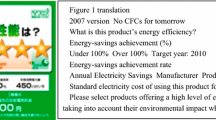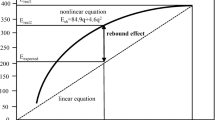Abstract
The Home Appliance Eco-Point System was a subsidy program implemented by the Japanese government from May 2009 to March 2011. The system has two features. First, the subsidy was provided in the form of eco-points that were only exchangeable for environmentally friendly goods. Second, it was a replacement subsidy program for durable goods with uncertain termination dates. We investigate the policy implications of these features. We show that if the eco-points are exchangeable for any goods (i.e., if a simple rebate program rather than an eco-point system is implemented), the same outcome can be achieved at a lower subsidy rate and thus using fewer financial resources. Regarding the eco-point system as a replacement subsidy, we show that the uncertain termination has the same effect as an increase in the subsidy: both accelerate the replacement. Uncertainty is a substitute for a subsidy, thus saving the financial resources of the government. However, there are two welfare concerns: (a) acceleration may not be desirable in terms of the environment, and (b) it costs households their expected utility.

Similar content being viewed by others
Notes
I am grateful to Geum Soo Kim for this information.
Commercial Times (July 31, 2015), a newspaper in Taiwan (http://www.chinatimes.com/realtimenews/20150730003163-260410. Access on October 15, 2015).
\(x_{1}^{D * } = 0\) (the case where the first inequality holds with strict inequality) is unrealistic and less interesting because the dirty good is only purchased using the eco-points. The associated rebate rate is given by \(\delta^{II} = p^{D} x_{D}^{*} /p^{C} x_{C}^{*}\).
Even in the special case in which the clean good does not have an externality (\(D_{{x^{C} }} = 0\)), the subsidy rate in (Eq. 8) is different from that of the Pigouvian subsidy, because the object of the subsidy is different. Note that the Pigouvian subsidy should be aimed at reducing consumption of the dirty good.
In this section, we consider the monetary measure of the utility change, i.e., benefits and costs. Instead, the reader may interpret that this section uses money-metric utility.
A more plausible assumption would be that the improvement depends on time, rather than the number of replacement. Our assumption, however, makes the analysis simple and provides a good starting point from which to consider the problem.
References
Baumol WJ, Oates WE (1988) The theory of environmental policy, 2nd edn. Cambridge University Press, Cambridge
Chang C-C, Sheu S-Y, Chen Y-L, Zhang ZG (2011) A multi-criteria optimal replacement policy for a system subject to shocks. Computer and Industrial Engineering 61:1035–1043
Fernandez VP (2000) Decisions to replace consumer durables goods: an econometric application of wiener and renewal processes. Review of Economics and Statistics 82:452–461
Ministry of Economy, Trade and Industry (2010) White Paper on International Economy and Trade 2010. http://www.meti.go.jp/english/report/data/gIT2010maine.html. Accessed 6 May 2015
Ministry of Economy, Trade and Industry (2011) Effects of the Home Appliance Eco-Point System Policy: the reference of the METI New Release on July 13, 2011. http://www.meti.go.jp/english/press/2011/0614_01.html. Access 6 May 2015
Prince JT (2009) How do households choose quality and time to replacement for a rapidly improving durable good? International Journal of Industrial Organization 27:302–311
Shoda Y (2011) An overview of Japan’s environmental policy. In: Paper prepared for the 11th Tripartite Roundtable on Environmental Industry, Ministry of the Environment. https://www.env.go.jp/en/focus/docs/files/20111109-07.pdf. Accessed 6 May 2015
Acknowledgments
I am grateful to Tsung-Hsiu Tsai, Geum Soo Kim, Hsiao-Chi Chen, and an anonymous referee for their helpful comments. This study originated from the research project “A theoretical and empirical study on the effect of introducing a new eco-friendly system to market transactions,” which was supported by the Ministry of the Environment as one of the FY 2009–2011 Environmental Economic Policy Research Projects. I am grateful to the Ministry of the Environment for financial support and to the project members, especially Ayu Washizu, Satoshi Nakano and Satoshi Kurokawa, for their helpful comments.
Author information
Authors and Affiliations
Corresponding author
About this article
Cite this article
Akao, KI. An economic analysis of the “Home Appliance Eco-Point System” in Japan. Environ Econ Policy Stud 19, 483–501 (2017). https://doi.org/10.1007/s10018-016-0156-3
Received:
Accepted:
Published:
Issue Date:
DOI: https://doi.org/10.1007/s10018-016-0156-3




